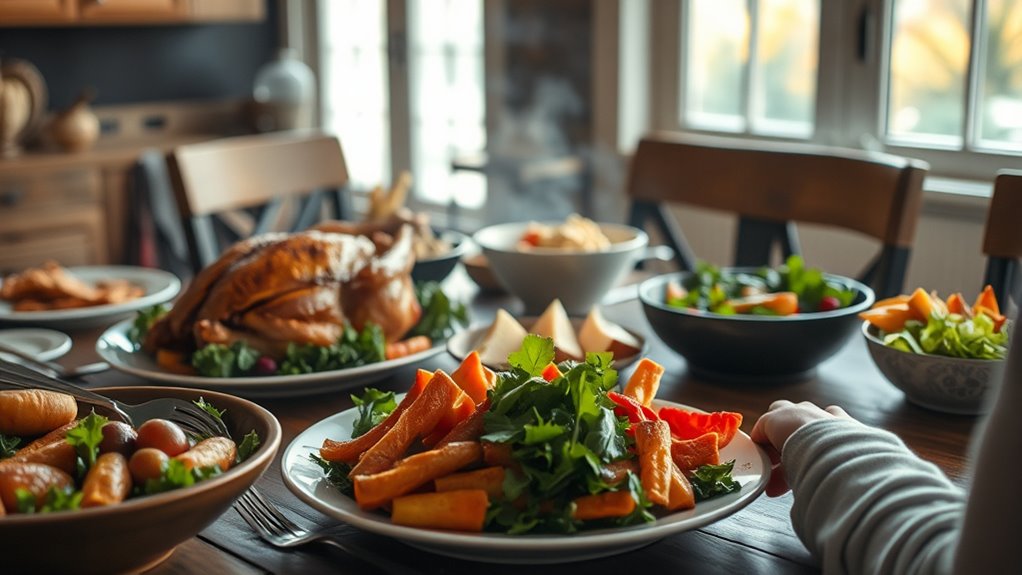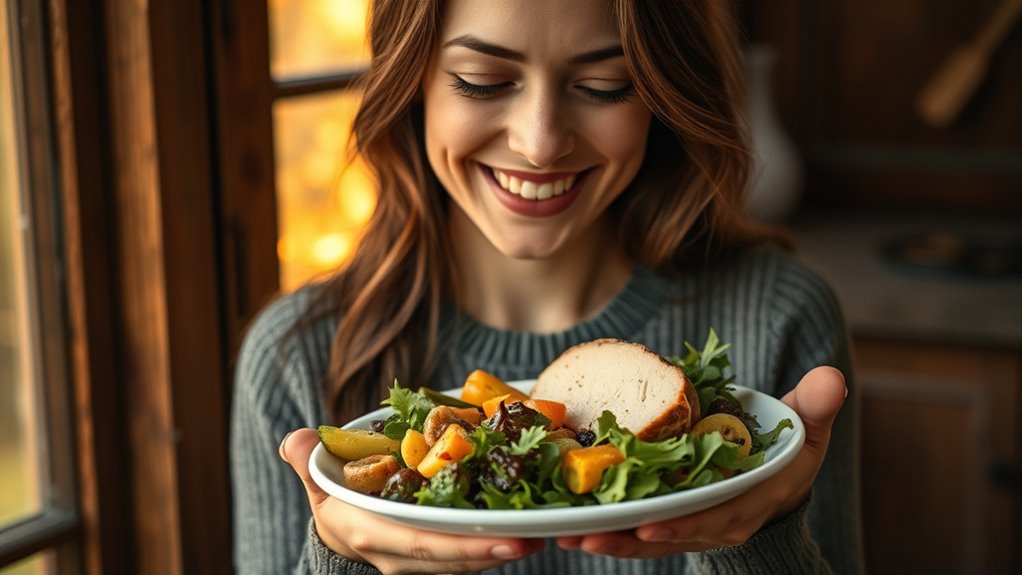To enjoy your Thanksgiving feast without overeating, focus on mindful eating. Slow down, take in the aromas and textures, and truly savor each bite. Serve smaller portions on a smaller plate, and pause frequently to gauge your fullness. Appreciate the effort behind the meal and stay present with your hunger signals. These strategies help prevent guilt and discomfort while allowing you to enjoy your favorite dishes fully. Keep exploring for more tips to make this holiday both enjoyable and balanced.
Key Takeaways
- Set an intention to savor each bite and appreciate the flavors, textures, and effort behind the meal.
- Serve smaller portions and use visual cues like dividing your plate to promote balanced eating.
- Slow down during meals, chew thoroughly, and take breaks to recognize hunger and fullness cues.
- Focus on sensory details such as aroma and texture to enhance enjoyment without overeating.
- Remember that second helpings are okay if still hungry, allowing for mindful flexibility.

Have you ever wondered how to enjoy your Thanksgiving feast without feeling overwhelmed or guilty afterward? The key lies in practicing mindful eating, which encourages you to focus on the present moment and truly appreciate your food. One effective strategy is to pay attention to portion control. Instead of piling your plate high, serve yourself smaller portions, allowing you to enjoy a variety of dishes without overindulging. Remember, you can always go back for seconds if you’re still hungry, but starting with moderate servings helps prevent overeating from the outset. This approach not only keeps your calorie intake in check but also enhances your appreciation for each bite.
Another important aspect of mindful eating is savoring flavors. As you fill your plate, take a moment to consider each dish—the aroma, the textures, the seasonings. When you sit down to eat, slow down and really taste what’s on your plate. Chew thoroughly, notice the different layers of flavor, and avoid rushing through your meal. Savoring flavors turns eating into a more intentional experience, making each bite more satisfying and less likely to leave you craving more. This mindful approach helps you tune into your body’s hunger cues, so you can better recognize when you’re truly full, rather than eating out of habit or distraction.
Savor each bite to make your Thanksgiving meal more satisfying and mindful.
To incorporate portion control and savoring flavors into your Thanksgiving, start by setting an intention before you begin eating. Take a moment to appreciate the effort that went into preparing the meal and the company you’re sharing it with. Use smaller plates or bowls to help manage your portions visually and physically. When serving, think about dividing your plate into sections—filling half with vegetables, a quarter with protein, and a quarter with carbs—to create a balanced meal. As you eat, focus on the sensory experience: the warmth of the food, the richness of the gravy, the crunch of fresh vegetables. Take breaks between bites, and check in with your body to see how you’re feeling. Are you still hungry, or just eating because it’s there?
In addition, practicing mindful eating can help you prevent overeating, allowing you to enjoy your favorite dishes without guilt or discomfort. Practicing these mindful habits doesn’t mean you have to skip your favorite dishes. Instead, it helps you enjoy them more fully and avoid the post-meal slump of guilt or discomfort. By controlling your portions and savoring each flavor, you turn your Thanksgiving meal into a nourishing, enjoyable experience that leaves you feeling satisfied—not stuffed or sluggish. This way, you get to celebrate without sacrificing your well-being or your enjoyment of the holiday.
Frequently Asked Questions
How Can I Stay Mindful When Surrounded by Tempting Desserts?
To stay mindful around tempting desserts, practice dessert moderation by choosing just one or two favorites instead of trying everything. Keep temptation awareness front and center—pause before you eat, ask if you’re truly hungry, and savor each bite slowly. Focus on the flavors and textures, which helps you enjoy the dessert without overdoing it. This way, you maintain control and enjoy the treats guilt-free.
What Are Quick Mindful Eating Techniques for Busy Thanksgiving Days?
Ever wonder how to stay mindful during a busy Thanksgiving? Try quick mindful eating techniques by practicing mindful portioning—serve yourself smaller amounts first. Savor slowdowns by pausing between bites, truly tasting each flavor. These simple steps help you stay present, prevent overeating, and fully enjoy the moment. Even on hectic days, a few mindful pauses can transform your eating experience into one of gratitude and balance.
How Do I Handle Family Pressure to Eat More?
You handle family pressure to eat more by setting boundaries through assertive communication. Kindly but firmly, let them know you’re satisfied or choosing to eat mindfully. Say something like, “I appreciate the offer, but I’m full for now.” This approach respects your choices and encourages understanding. Remember, you control your plate, and setting boundaries helps you enjoy the feast without overdoing it, all while maintaining family harmony.
Can Mindful Eating Improve Digestion After Heavy Meals?
Yes, mindful eating can improve your digestion after heavy meals. By paying attention to your hunger cues and eating slowly, you encourage mindful digestion, which reduces bloating and discomfort. When you focus on chewing thoroughly and savoring each bite, you support better digestive health. This intentional approach helps your body process food more efficiently, making you feel lighter and more comfortable after a hearty feast.
What Are Some Mindful Eating Exercises to Practice Before the Feast?
Before your feast, practice mindful eating exercises like savoring techniques by slowly tasting and appreciating each bite. Focus on portion control by pre-serving small portions or using smaller plates. Take a few deep breaths to center yourself and set intentions for mindful eating. These practices help you enjoy your food more, prevent overeating, and foster gratitude, making your Thanksgiving meal more fulfilling and balanced.
Conclusion
By practicing mindful eating this Thanksgiving, you’ll enjoy every bite without the guilt of overeating. Remember, studies show that mindful eaters tend to consume 20% fewer calories and feel more satisfied after meals. So, take your time, savor each flavor, and listen to your body’s signals. This way, you can indulge in the feast while staying true to your wellness goals. Make this holiday both joyful and balanced!








